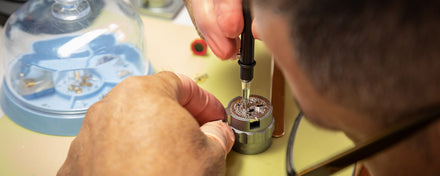Watch Repairs


Bracelet Sizing, Strap Adjustment & Clasp Adjustment
- Bracelet type: Certain bracelet styles, like metal link bracelets, may require slightly more length due to their bulk compared to a thinner leather strap.
- Micro-adjustments: Some clasps offer micro-adjustment holes that allow for fine-tuning the fit after attaching the bracelet.
Here are some tips for watch bracelet sizing:
- Consult a watch manufacturer's guide or jeweler for specific recommendations for your watch model.
- If buying online, look for retailers that offer information about bracelet length or sizing guides.
- Consider purchasing a bracelet with removable links for easier adjustment at home.
- Battery Replacement at End of Life: To ensure optimal performance and longevity of your quartz watch, it's recommended to replace the battery when the watch stops functioning.
- End-of-Life (EOL) Indicator System: If your watch features an EOL system, a jumping seconds hand (advancing once every four to five seconds) signifies a low battery.
- Prompt Battery Change is Crucial: We strongly advise replacing the battery as soon as the watch stops. Leaving a depleted battery in the watch can lead to leakage and potentially damage the movement.
- Importance of Authorized Service Centers: For professional battery replacement and to safeguard your timepiece, we recommend entrusting your watch to an authorized service center.
- Opening of the case back
- Battery Replacement
- Electronic tests according to movement technical specification
- Replacement of the case back gasket and case back tightening and locking
- Water Resistance Test with a vacuum tester or pressure proof machine
- Watch Cleaning
- Functional checks and performance test
Polishing


- Preparation: The watchmaker will first remove the bracelet, strap, and any removable parts like the crown to isolate the case for polishing.
- Cleaning: The case and bracelet are thoroughly cleaned to remove dirt, dust, and any oils or residues that might interfere with the polishing process.
- Scratch Removal: Depending on the severity of the scratches, different polishing techniques are employed.
- Mild scratches: Buffing with a soft polishing compound might suffice.
- Deeper scratches: A polishing wheel with a more abrasive compound may be required. In some cases, hand polishing with a special tool might be necessary.
- Final Polish: After removing scratches, a final polish with a finer compound is used to achieve a high-gloss finish. In some instances, different polishing cloths or brushes might be used depending on the material and desired finish (brushed or high polish).
- Reassembly: Once polishing is complete, the watchmaker carefully reassembles the watch, ensuring all parts are secure and functioning properly.
- Improved Aesthetics: Polishing restores the watch's original shine and removes unsightly scratches, enhancing its overall appearance.
- Increased Value: A well-maintained watch with a polished exterior retains its value better over time.
- Enhanced Protection: Polishing can help remove surface-level dirt and grime, potentially reducing the risk of further scratches and wear.
- Material: The polishing technique used will vary depending on the watch's material (stainless steel, gold, titanium, etc.). Each material has specific properties that require appropriate polishing methods to avoid damage.
- Depth of Scratches: While polishing can address many scratches, very deep scratches or dents might require more extensive repairs beyond polishing.
- Professional Service: For optimal results and to avoid damaging the watch, it's recommended to seek professional watch polishing services from a qualified watchmaker or jeweler.


A thorough examination of the watch case and bracelet/strap is conducted to identify any signs of wear or damage.
The bracelet is detached, followed by the careful opening of the case. The stem, crown, seals, and movement are then meticulously removed.
The stem and crown are reattached, and the functionality of the winding mechanism is meticulously assessed.
Proper operation of both hands and calendar functions (if applicable) is confirmed.
The escapement, a critical component for timekeeping accuracy, undergoes a detailed inspection and receives any necessary adjustments.
The watch case is fully disassembled, allowing for a meticulous inspection of the movement and all its individual components.
Any parts identified as worn or damaged during the inspection are replaced with high-quality components.

All components are thoroughly cleaned in specialized chemical baths within automated cleaning machines.
The movement is carefully reassembled, followed by verification and fine adjustments to meet brand-specific performance standards.
For movements requiring lubrication, high-quality oils and greases are precisely applied. A subsequent examination of the escapement ensures proper function.
The movement is demagnetized to eliminate any magnetic interference, followed by regulation and a comprehensive evaluation of its timekeeping accuracy using specialized Swiss timing equipment.
The dial and hands are carefully refitted onto the movement. The case and bracelet then undergo a meticulous cleaning using advanced ultrasonic technology.
If necessary, case seals are replaced to maintain water resistance, and the movement is securely re-inserted into the case.
The timekeeping performance is assessed one last time, with adjustments made if required using specialized timing equipment.


A thorough examination of the watch case and bracelet/strap for any signs of wear or damage.
Following case opening and removal of the stem and crown, a detailed assessment of the setting mechanism’s functionality.
Verification of proper operation for both hands and calendar functions (if applicable).
Disassembly of the movement for a meticulous inspection of all mechanical components and the electronic module.
Replacement of any worn or malfunctioning mechanical or electronic parts identified during the inspection.
Utilizing automated cleaning machines with specialized chemical baths, all mechanical parts are thoroughly cleaned.

The movement is carefully reassembled, followed by verification and fine adjustments to meet brand-specific performance standards.
Precise lubrication of the setting and calendar mechanisms using high-quality oils and greases.
Utilizing specialized Swiss electronic testing equipment, the timekeeping accuracy of the movement is thoroughly evaluated.
The dial and hands are carefully refitted, followed by a meticulous cleaning of the case and bracelet using advanced ultrasonic technology.
If necessary, case seals are replaced to maintain water resistance, and the movement is securely re-inserted into the case.

- Ring Resizing: This is a frequent repair, adjusting the ring band to fit your finger comfortably. Some rings can be resized by stretching or compressing the band, while others may require adding or removing a small piece of metal.
- Ring Setting Repair: Prongs that hold gemstones in place can become loose or damaged over time. Repair involves re-tipping the prongs (rebuilding the worn parts) or replacing them entirely to secure the gemstone safely.
- Stone Replacement: Chipped, cracked, or lost gemstones can significantly diminish the beauty of a ring. A skilled jeweler can replace damaged stones with a perfect match, considering size, shape, and color to maintain the piece's original appearance and value.
- Clasp Repair: A faulty clasp can be frustrating and lead to lost jewelry. Jewelers can repair or replace broken clasps, ensuring your necklace stays securely fastened.
- Chain Repair: Chains are susceptible to breakage, especially delicate chains or those worn frequently. A jeweler can solder broken links or reinforce weak areas to restore the chain's strength and prevent future breaks.
- Soldering: This technique is used for various repairs, including ring resizing, attaching jump rings to charms, or reattaching broken earring posts.
- Pearl Restringing: Pearls can weaken over time and require restringing on a new silk or nylon thread to prevent them from losing their shape or falling apart.
- Cleaning and Polishing: Regular cleaning and polishing removes dirt, grime, and tarnish, restoring shine and luster to your jewelry.
- Metal Type: The repair technique will depend on the type of metal the jewelry is made of (gold, silver, platinum, etc.).
- Gemstone Type: Certain gemstones require special care during repairs due to their hardness or fragility.
- Complexity of Repair: Simple repairs like clasp replacements might be completed while you wait, while more intricate repairs may require leaving your piece with the jeweler for a longer period.



